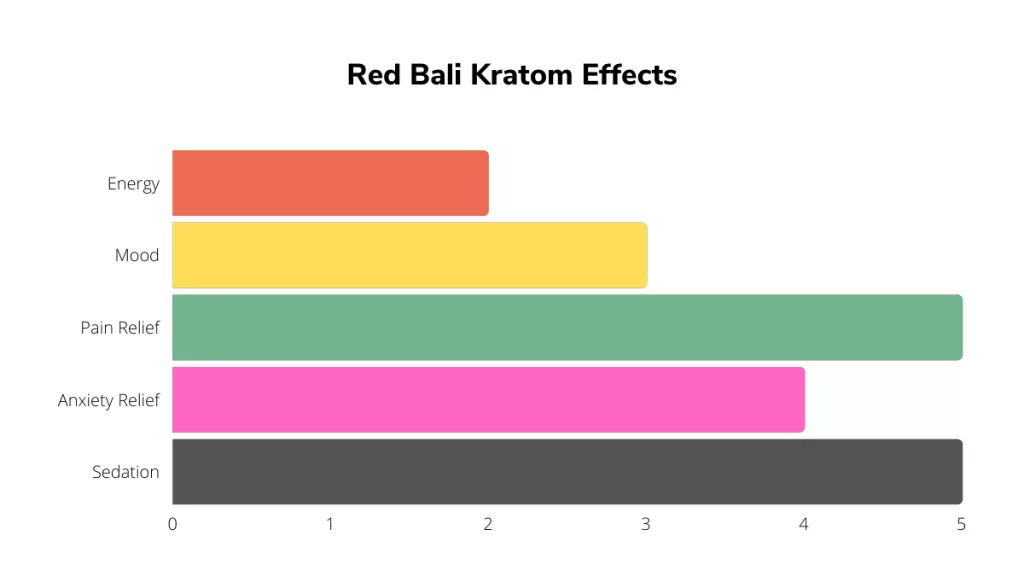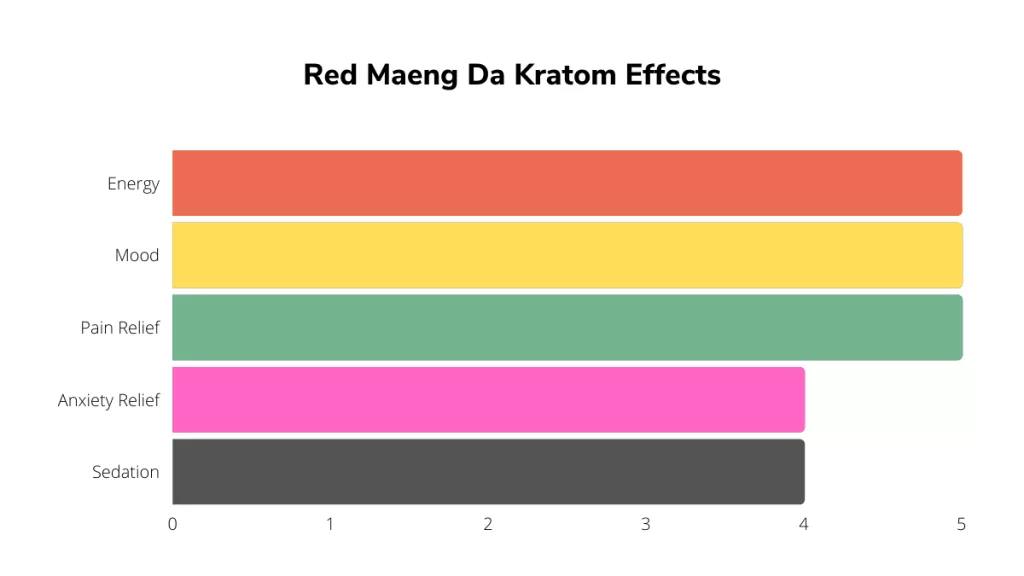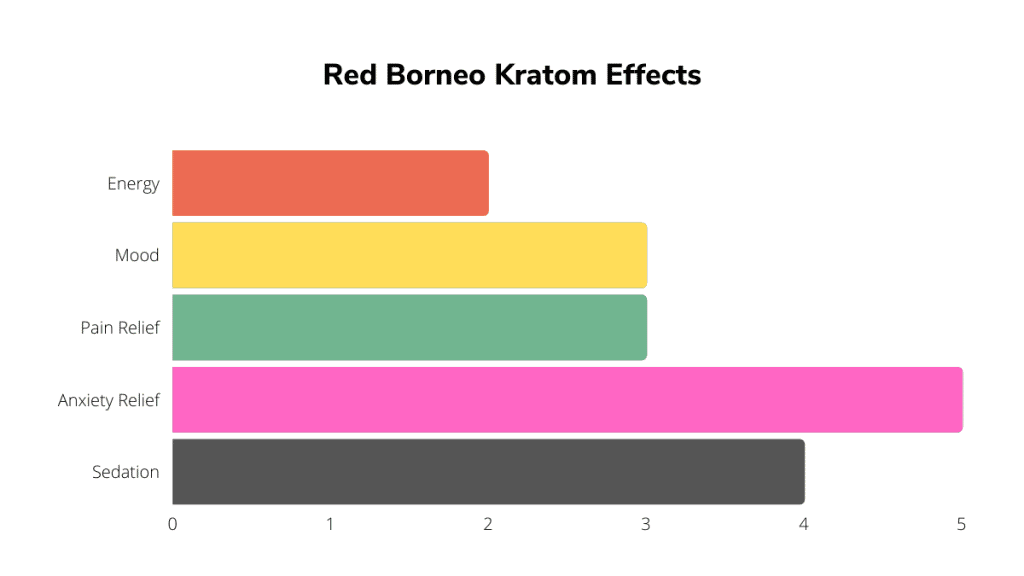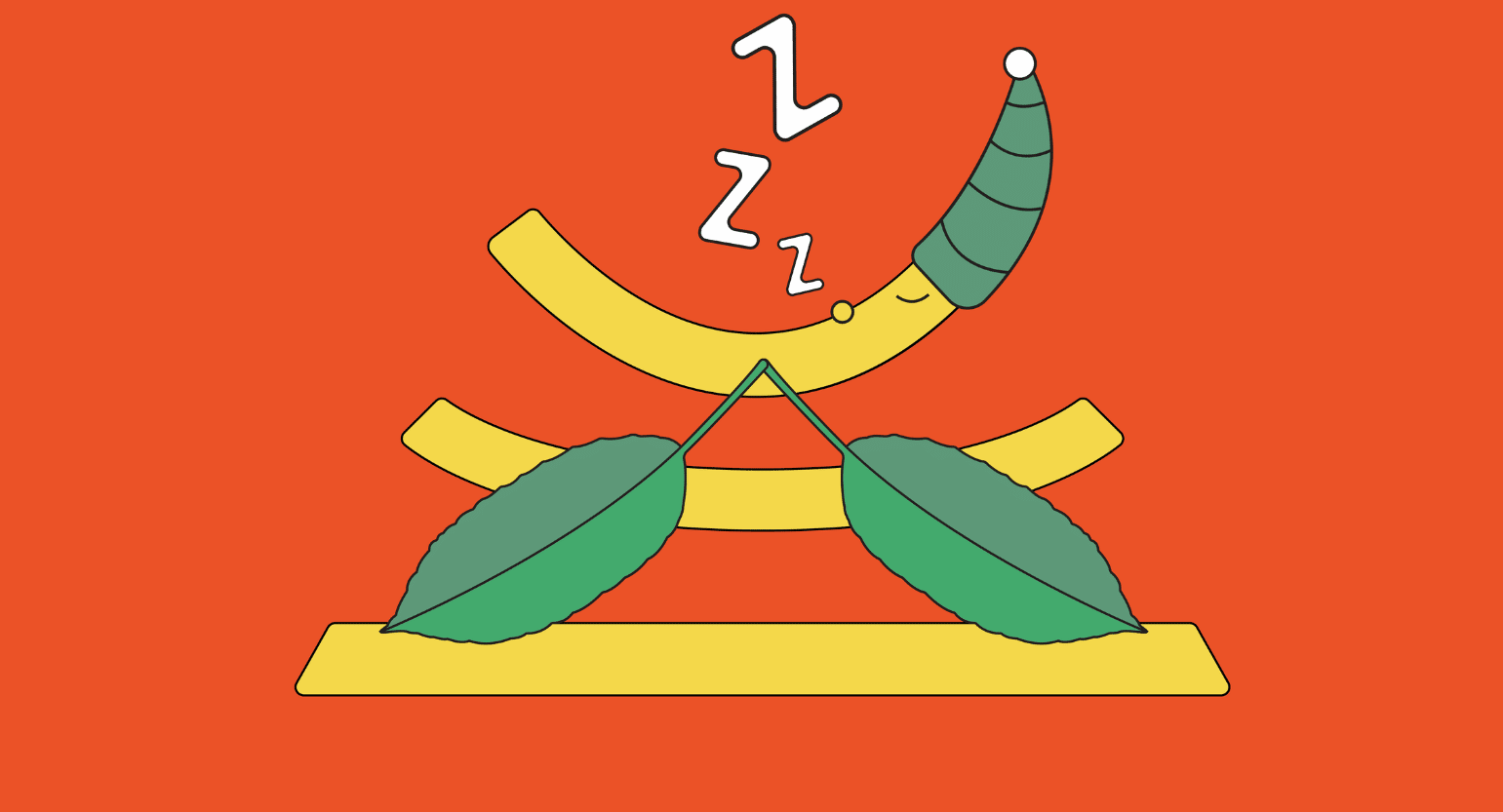What Is Kratom?
Kratom (Mitragyna speciosa) is a natural herb from Southeast Asia with a host of interesting effects and benefits. Ground dried kratom leaves feature heavily in traditional Thai medicine for their ability to relieve pain, improve mood, and increase a person’s overall sense of well-being.
Kratom comes in three main strains: red-vein, green-vein, and white-vein. The colors refer to the veins that run through the plant’s leaves, and each strain has a distinct set of effects. Red kratom is the most sedating and widely considered the best option for treating pain.
Can Kratom Help With Chronic Back Pain?
Many people use kratom as an alternative treatment for pain, including back pain. Kratom works by blocking pain signals before the brain can process them, so it’s effective against any type of pain, irrespective of the underlying cause [1].
Kratom contains many naturally occurring chemicals called alkaloids that interact with the body’s opioid receptors to dull pain. Mitragynine and 7-hydroxymitragynine are the two most essential alkaloids for pain relief, and strains with high concentrations of 7-hydroxymitragynine are the best for treating chronic back pain.
It’s important to realize that kratom is not an opioid despite its similar biological activity. Kratom also is a natural relaxant that may reduce muscle tension, making it especially useful for alleviating back pain from muscle spasms.
Kratom also interacts with the nervous system’s neurotransmitters to alter one’s perception of pain.
Kratom, Dopamine, & Chronic Back Pain
Kratom affects the concentration of dopamine in the central nervous system (CNS) and, therefore, can indirectly relieve pain by changing how the brain interprets pain signals [2]. Dopamine is often incorrectly thought of as the brain’s pleasure chemical, but it’s more accurately the motivation chemical.
Studies have shown that dopamine influences how we learn to anticipate and react to external stimuli, changing our perception of pain. One study explored the relationship between kratom and dopamine, finding that dopamine concentrations in the brain and spinal cord increased after taking kratom [3]. This activity led to long-term changes in pain perception, reducing sensitivity which could help people manage their pain more easily.
Kratom, Serotonin, & Chronic Back Pain
Kratom also affects serotonin levels and increases its absorption in the CNS [4]. Serotonin is a crucial neurotransmitter that affects learning, cognition, memory, and mood. Even though serotonin doesn’t directly affect pain, it can change one’s ability to tolerate pain by regulating mood and outlook.
Depression and anxiety are common among people who suffer from chronic pain conditions like back pain. In extreme cases, doctors may prescribe serotonin and norepinephrine reuptake inhibitor (SNRI) drugs to increase available serotonin in the CNS. These work well for managing pain and pain-related depression but are wildly addicting.
Although it is not an SNRI drug, kratom has a similar effect on serotonin levels. Some researchers hypothesize that kratom’s effect on serotonin may increase pain tolerance and improve mental state when dealing with chronic conditions like back pain.
Related: Tips to Relieve Pain from Golf Injuries.

Best Kratom Strains for Relieving Chronic Back Pain
Experienced kratom users agree that red strains are best for pain relief. More specifically, strains with high 7-hydroxymitragynine concentrations are expected to be more potent analgesics.
Reputable kratom companies publish third-party testing results on their websites, and these reports sometimes include information about a strain’s alkaloid content. If you can find information about alkaloid content before you buy, look for strains with higher levels of 7-hydroxymitragynine.
1. Red Bali
Red Bali is a capable pain-reliever without being overwhelming, making it an excellent choice for new users. It also provides ample relaxation, which can help with tension-related back pain from cramps and muscle spasms. The only downside is that Red Bali isn’t very potent, so it might not be strong enough for severe cases.

2. Red Maeng Da
If Red Bali turns out to be too weak for your chronic back pain, Red Maeng Da is a more potent strain that offers more pain relief and relaxation. Some people consider Red Maeng Da to be the premier strain for pain due to its unusually high levels of 7-hydroxymitragynine. However, Red Maeng Da has a greater likelihood of causing side effects and is less suitable for inexperienced users.

3. Red Borneo
Red Borneo is closer in strength to Red Bali than Red Maeng Da but has a slightly different alkaloid profile that gives it unique effects. It’s somewhat more relaxing than Red Bali, with some users reporting that it makes them sleepy and tired. This could benefit people with severe chronic back pain that gives them trouble sleeping, although it may be undesirable for people looking for a strain to help them stay active.

Risks of Using Kratom for Chronic Back Pain Relief
Kratom is often used to treat back pain as an alternative to dangerous, addicting painkillers, but that doesn’t mean it doesn’t come with its own risks.
The most common side effects of kratom are dizziness, confusion, memory impairment, nausea, constipation, diarrhea, anxiety, and lethargy.
Addiction is the most severe risk of using kratom. Even though kratom is not an opioid, it can cause physical dependence and addiction. According to experts, managing your intake is the best way to avoid developing a kratom addiction. Experienced kratom users also suggest taking at least one week off from using kratom every one to two months. Listen to your body and take a break if you feel lethargic.
Is It Safe to Take Kratom with Other Pain Medication?
Combining kratom with other pain medication is not recommended. Drug interactions are complicated and may have severe side effects. Consult a doctor before taking kratom if you take pain medication or other drugs.
Kratom vs. Motrin for Chronic Back Pain
Motrin is a brand name for ibuprofen, a common over-the-counter pain-reliever. For moderate to severe back pain, some doctors prescribe a stronger version of Motrin that is two to three times more than what is available from your local drug store.
Motrin is a non-steroidal anti-inflammatory drug (NSAID), which means that it relieves pain by reducing inflammation and swelling. NSAIDs are great for relieving many types of pain, including back pain, although they come with several concerning side effects. Combining kratom and NSAIDs comes with a low to medium risk, but always check with your doctor before mixing them.
Prescription-strength Motrin needs to be used carefully to avoid stomach bleeding, ulcers, and other gastrointestinal problems.
Motrin can be more effective than kratom for some forms of chronic back pain but is also considered riskier by some people. However, the risk of addiction is much lower for Motrin than kratom.
Comparing Motrin & Kratom:
| 🍃 kratom | 💊 Motrin | |
| Availability | Unrestricted | Prescription, OTC |
| Natural or Synthetic? | Natural | Synthetic |
| Active Ingredient | Mitragynine, 7-hydroxy-mitragynine, & other plant-derived alkaloids | Ibuprofen |
| Indications | Boost energy & focus, chronic pain, opiate withdrawal, anxiety, & sleep | Pain, inflammation |
| Dosage | 2-12 grams per day | 400-600 mg per day |
| Common Side Effects | Nausea, vomiting, lethargy, dizziness, anxiety, brain fog, constipation | Ulcers, stomach bleeding, intestinal lining breakdown, headache, constipation, dizziness |
| Level of Risk | Low-Moderate | Hige |
| Risk of Addiction | Moderate | Low |
| Cost | $10 – $20 an ounce (~30 grams) | $400-$500 for thirty 600 mg capsules |
Kratom vs. Zanaflex for Chronic Back Pain
Zanaflex is a muscle relaxer used to treat tight, spastic muscles. Zanaflex can be used to treat back pain caused by muscle spasms but won’t be effective against other sources of back pain. However, chronic back pain can sometimes cause tight muscles and stiffness since people naturally tense up when in pain.
Zanaflex is a stronger muscle relaxer than kratom, although it doesn’t have the additional benefit of being a pain-reliever like kratom does. Kratom and Zanaflex are moderately habit-forming and require similar care to avoid addiction.
Comparing Zanaflex & Kratom:
| 🍃 kratom | 💊 Zanaflex | |
| Availability | Unrestricted | Prescription-Only |
| Natural or Synthetic? | Natural | Synthetic |
| Active Ingredient | Mitragynine, 7-hydroxy-mitragynine, & other plant-derived alkaloids | Tizanidine |
| Indications | Boost energy & focus, chronic pain, opiate withdrawal, anxiety, & sleep | Spasticity, multiple sclerosis, spinal cord injuries |
| Dosage | 2-12 grams per day | 2-4 mg per day |
| Common Side Effects | Nausea, vomiting, lethargy, dizziness, anxiety, brain fog, constipation | Dizziness, lightheadedness, constipation, dry mouth, weakness, tiredness |
| Level of Risk | Low-Moderate | Moderate-high |
| Risk of Addiction | Moderate | Moderate |
| Cost | $10 – $20 an ounce (~30 grams) | $90-$100 for thirty 4 mg tablets |
Kratom vs. Vicodin for Chronic Back Pain
Some back pain is so severe that NSAIDs and muscle relaxers aren’t enough. Some doctors may turn to opioids as a last result for these cases. Although it is generally considered risky, Vicodin is a powerful opioid that can dull even excruciating back pain.
Vicodin is a combination of acetaminophen and hydrocodone, meaning it comes with an outsized risk of addiction and could damage the liver and kidneys if used incorrectly. It also isn’t a long-term solution due to its dangerous side effects. It is considerably more effective than kratom for eliminating back pain, although most people find it isn’t worth the higher risk.
Never use Vicodin and kratom together.
Comparing Vicodin & Kratom:
| 🍃 kratom | 💊 Vicodin | |
| Availability | Unrestricted | Prescription-Only |
| Natural or Synthetic? | Natural | Synthetic |
| Active Ingredient | Mitragynine, 7-hydroxy-mitragynine, & other plant-derived alkaloids | Acetaminophen/hydrocodone |
| Indications | Boost energy & focus, chronic pain, opiate withdrawal, anxiety, & sleep | Pain |
| Dosage | 2-12 grams per day | 300 mg per day |
| Common Side Effects | Nausea, vomiting, lethargy, dizziness, anxiety, brain fog, constipation | Liver damage, kidney damage, constipation, intense drowsiness, allergic reactions, rash, hives |
| Level of Risk | Low-Moderate | High |
| Risk of Addiction | Moderate | High |
| Cost | $10 – $20 an ounce (~30 grams) | $150-$25 for ten 300 mg tablets |
How Common is Chronic Back Pain?
Back pain is extremely common, with an estimated 25% of adults suffering from some form of back pain. It is one of the leading causes of work disability and accounts for a significant chunk of chronic pain cases in the United States.
The spine is a delicate structure and requires the right blend of stability and flexibility in the right places. Chronic back pain can be caused by injury but is also caused by leading a sedentary lifestyle. With more of the workforce sitting at computers all day, back pain rates are rising, putting strain on people’s spines and the healthcare system alike.
Taking preventative steps when you first notice chronic back pain could go a long way towards easing your discomfort and allowing you to avoid serious complications. However, taking the proper steps requires knowing the signs and symptoms of back pain.
Signs & Symptoms of Chronic Back Pain
You might think that back pain is easy to spot, but that’s not always the case. Pain in the back, especially the lower back, with movement is an extremely common sign of a back injury, but back pain can also manifest in less obvious ways.
Back injuries and pain can also lead to pain in the hips, legs, and neck due to compressed nerves or postural issues that develop from trying to avoid painful movements and positions. Sciatica is usually felt in the hip and upper leg but is often caused by problems in the back.
Pay attention to which movements and positions trigger pain if you suspect a back injury. Getting the proper treatment depends on sharing information with a medical professional so they can correctly diagnose your condition.
Common Treatments for Chronic Back Pain
Many people attempt to treat back pain themselves, turning to over-the-counter NSAIDs like Advil and Motrin or other common painkillers like Tylenol. These drugs may take the edge off but are not strong enough for severe cases and unsuitable for long-term use.
Physical therapy is often an option for treating back pain, although it depends on what is causing your pain. Most people need a prescription to attend physical therapy, and the costs can add up quickly. However, many people are surprised by how effective physical therapy can be once they give it a chance.

Key Takeaways: Can Kratom Help With Chronic Back Pain?
Back pain is one of the most common afflictions affecting adults in the United States and one of the leading reasons doctors prescribe dangerous pain medication. Some people have turned to kratom instead, preferring a natural alternative to powerful prescription pills. Kratom offers an alternative path for many people with chronic back pain, giving them hope when they need it.
However, kratom is not a miracle herb, and there are some dangers associated with its use. The most concerning risk of using kratom is addiction. Experts suggest limiting kratom use to just four or five days per week to reduce the chances of becoming dependent.
If you’re going to try kratom for back pain, experienced users usually suggest red strains. They’re higher in 7-hydroxymitragynine, making them more potent pain-relievers than other strains. Experimenting with your dose is part of the kratom learning process, but most people recommend starting slowly to be safe.
- Eastlack, S. C., Cornett, E. M., & Kaye, A. D. (2020). Kratom—Pharmacology, clinical implications, and outlook: a comprehensive review. Pain and therapy, 9(1), 55-69.
- Stolt, A. C., Schröder, H., Neurath, H., Grecksch, G., Höllt, V., Meyer, M. R., … & Becker, A. (2014). Behavioral and neurochemical characterization of kratom (Mitragyna speciosa) extract. Psychopharmacology, 231(1), 13-25.
- Johnson, L. E., Balyan, L., Magdalany, A., Saeed, F., Salinas, R., Wallace, S., … & Grundmann, O. (2020). Focus: Plant-based Medicine and Pharmacology: The Potential for Kratom as an Antidepressant and Antipsychotic. The Yale Journal of Biology and Medicine, 93(2), 283.
- Anand, A., & Hosanagar, A. (2022). The Addictive Potential and Challenges with Use of the “Herbal Supplement” Kratom: A Case Report and Literature Review. Pain Medicine, 23(1), 4-9.










